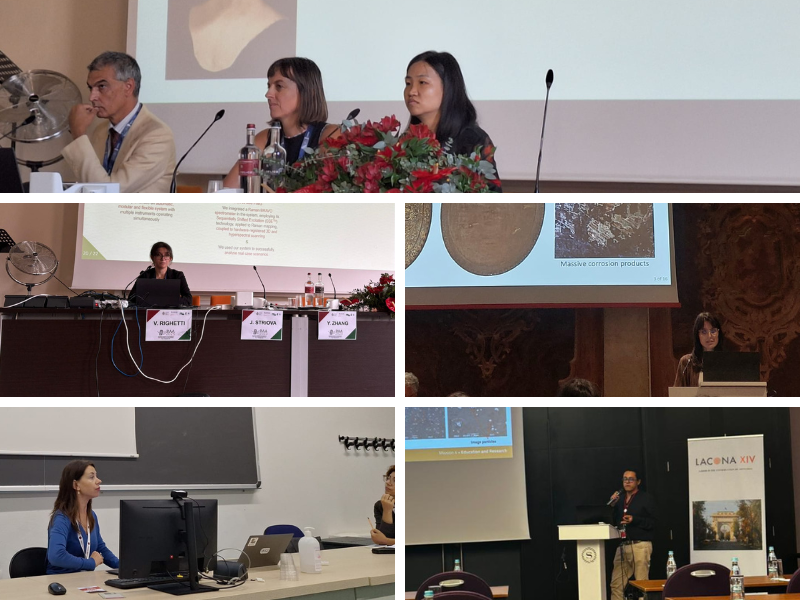The past week was an intense and rewarding one for the Heritage Science Group (HSG) at CNR-INO, with members presenting their latest research results at four major conferences across Europe. From Raman spectroscopy to digital training infrastructures, from conservation of metallic artifacts to advanced laser strategies for daguerreotypes, the group demonstrated the breadth and impact of its contributions to the field of heritage science.
Raman Innovations at RAA 2025 (Pisa, 3–6 September)
At the International Conference on the Application of Raman Spectroscopy in Art and Archaeology (RAA 2025) in Pisa (RAA 2025), Valentina Righetti and Jana Striova presented the pioneering work “Hardware-Registered Sequentially Shifted Excitation™️ Macro-Raman and 3D Mapping System for the Characterisation of Artwork Surfaces”.
Their presentation unveiled the first application of Sequentially Shifted Excitation™️ Raman spectroscopy integrated with 3D mapping and Reflectance Imaging Spectroscopy for cultural heritage. This innovative multimodal and hardware-registered platform enables fluorescence-free spectral imaging, while simultaneously revealing both the chemical composition and the surface topography of artworks. A powerful step forward in non-invasive heritage science diagnostics.
Digital Heritage 2025 (Siena, 8–13 September)
On September 10, Antonina Chaban took the stage at the Digital Heritage 2025 Conference in Siena (Digital Heritage 2025) with the talk “Bridging Disciplines for Heritage Professionals: The H2IOSC Digital Training Platform (by CLARIN, DARIAH, E-RIHS and OPERAS)”.
She presented the H2IOSC Training Platform as an innovative digital infrastructure designed to deliver FAIR training materials, adaptable courses, and interactive experiences enhanced with gamification and collaborative features. Supporting interdisciplinary learning across Social Sciences, Digital Humanities, and Cultural Heritage, the platform fosters continuous professional development and creates new opportunities for cross-disciplinary knowledge exchange.
LACONA XIV (Bucharest, 9–12 September)
At LACONA XIV – Lasers in the Conservation of Artworks in Bucharest (LACONA 14), Diego Ivan Quintero Balbas presented the contribution “Integrated imaging and cleaning strategies for the diagnosis and restoration of daguerreotypes: access to advanced infrastructural research facilities”.
Within the LaserLab-Europe Research Infrastructure, his work showcased an integrated methodology combining multimodal imaging, spectroscopy, and laser-based cleaning strategies to document, diagnose, and conserve daguerreotypes—an early and fragile photographic medium. Tests with different laser sources (532, 355, 248, 193 nm; ns/fs regimes) demonstrated the selective removal of corrosion layers such as metallic sulfides and carbonates, while preserving delicate image details. This approach highlights the role of cutting-edge technologies and transnational access to research infrastructures in advancing heritage conservation.
DABC conference (Cremona, 10–13 September)
Meanwhile in Cremona, at the XXI Congresso Nazionale della Divisione di Chimica dell’Ambiente e dei Beni Culturali (Congresso DABC), Silvia Innocenti presented her research on the “Scientific Investigation and Cleaning Strategies for the Conservation of the Gilded Steel Shield of Captain Francesco Bernardo”, a historic object preserved at the Museo Civico Medievale di Bologna.
Her study employed a broad set of non-invasive analytical techniques—including XRF, FTIR, Raman, colorimetry, micro-profilometry, and OCT—to identify materials and assess the artifact’s condition. The diagnostic results informed the development and testing of targeted cleaning methods on mock-ups, demonstrating the effectiveness of integrated scientific approaches in addressing the conservation challenges of complex historical metalwork.
A Strong Presence on the International Stage
In the span of just a few days, HSG researchers contributed to major international conferences, each advancing knowledge and practice in heritage science from different perspectives—analytical innovation, digital infrastructures, conservation case studies, and laser-based diagnostics. These activities underline the commitment of the Heritage Science Group to developing and disseminating innovative tools, methods, and infrastructures for the preservation, study, and transmission of cultural heritage, while reinforcing the group’s active role in the international scientific community
